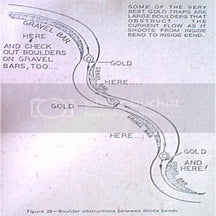
Reading the Stream
Reading the Stream
The most common obstruction to prevent the smooth flow of water in a mountainous river channel is the typical boulder. Boulders come in all shapes and sizes, ranging from minor nuisances a foot or two across up to gigantic masses of rock the size of a bungalow. Boulders that fall between these two extremes deserve the attention of the underwater prospector because they will often concentrate vast amounts of gold near their bases - mainly if they rest on bedrock. Strange things happen when the gold-carrying flood current of a river encounters a large boulder. Let's study Figure 27 to get the story.
In this hypothetical situation, we have a large,

somewhat rounded boulder in the middle of a stream that is at the height of its yearly flood stage. The current is flowing at a frightening clip, and we surely wouldn't want to fall in at this time! As the swift current slams into the upstream side of the boulder, it is deflected around the outside perimeter due to the roundness of the rock mass. When the current "rounds the corner" and approaches the downstream side of the boulder, it will start to circulate in an eddy motion around the rear of the boulder and practically standstill. If the stream current happens to be transporting gold, the heavy yellow metal will be carried along the perimeter of the boulder to settle in the still waters on the downstream side eventually.
Gold can be trapped on the upstream side of a boulder, but usually, there will have to be a substantial fissure in the face of the rock mass to catch the gold as it is thrown against the boulder by the current. Boulders often have yielded large amounts of gold to the dredger who diligently cleans them down to the base, but which boulders, specifically, are most apt to hold the golden treasure? The answer is simple - look for large boulders in mid-stream that obstruct the current flow as it travels from inside bend to inside bend. See Figure 28.
As we already know, gold tends to travel from the tip of one inside bend to the other,

but if there is an obstruction in the current flow as it shoots between curves (namely a boulder), some of the heavier gold will never make it to the inside of the next bend. Always keep an eye out for this type of condition, and check the downstream side of any large boulders that appear to be in the correct position.
One of the best of all possible spots for the deposition of placer gold will be an accumulation of large boulders at a point where a

stream channel widens. See Figure 29.
In the upper part of Figure 29, the river travels through an extremely narrow gap, a channel condition that causes currents to flow at tremendous speeds. The water is so swift it even carries large boulders which don't get a chance to settle in the narrows. As soon as the stream emerges from the narrows, the large boulders will drop immediately at the beginning of the widening. If you want to find a potential "super-sport," check the gravel on the downstream sides of boulders such as this.
Boulders are not the only objects to obstruct stream channels to the advantage of the gold-dredger. Another favorable location will be an area where a large section of bedrock protrudes out into a stream, causing an eddy current to circulate the outcropping.
Whenever a chunk of bedrock sticks out into a river on an angle slanting with the current, an eddy will circulate on the downstream side of the obstruction, causing a buildup of heavy material. This type of eddy is called a suction eddy. (Figure 30-A)

Figure 30-B) If the current flowing across the face of a downstream-slanted bedrock outcrop is fierce enough, it will sometimes shoot across the stream and cause an eddy to circulate an object on the opposite bank, known as a pressure eddy. (Figure30-B)
The nature of bedrock outcroppings that protrude into a channel against the current flow is tricky, and one would almost have to see the river in question at the height of its flood stage to get an idea of where the eddy currents will form.
An outcropping that protrudes far out into the current (as shown in Figure 31-A) will most likely catch the current on the outermost projection of the bedrock and cause an eddy to swirl in toward the shore. The spot indicated by the "X" would be a possible deposition area. If the outcropping is only a minor projection into the flow of the current (Figure 31-B), any number of things can happen.
The stream current can bypass the projection entirely, it can partially flow against the outcrop with the significant part running out toward the middle of the channel, or the central portion can flow against the outcrop and circulate in a "half-eddy," flushing the material in suspension back out into the middle of the stream. Now you can understand why I say an on-the-spot inspection of an upstream-slanted bedrock outcropping is a virtual necessity!
Every so often, you hear stories about how a gold-dredger recovered an incredible amount of gold from the base of a waterfall. Before you start getting "waterfall happy," let's set the record straight once and for all. The average waterfall - -if it is of any substantial height - Creates downward currents of extreme ferocity and will tend to carve a deep, turbulent boil hole right at its base. (See Figure 32)
Nine times out of ten, any gold coming over the falls will drop into this boil hole to

Be ground up into flakes that will soon wash out with the current. So in this sense, anyway, waterfalls should be avoided when you are out looking for dredging spots
But as we have seen many times during this text, there are exceptions to every rule, and in this case, the exception is a humdinger.
Every so often, a waterfall will flow over a layer of extremely hard, weather-resistant rock that overlays softer rock beneath. As water goes over the falls, it will cause the underlying softer rock to erode back under the upper layer of a harder material. This will create a kind if "cave" under the falls. (Figure 33)
If the cave happens to be below the water

line at the time of flooding, a powerful eddy current may develop, which will occasionally (and I do emphasize the word occasionally) cause heavy materials to swirl back into the cave and become entrapped. There have been several fabulously wealthy dredging finds taken from such locations, but you could count the total on the fingers of one hand. Even so, it won’t pay if you don’t take chances....investigate!

